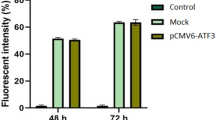Abstract
Human papillomavirus (HPV) E2 gene disruption is one of the key features of HPV-induced cervical malignant transformation. Though it is thought to prevent progression of carcinogenesis, the pro-apoptotic function of E2 protein remains poorly understood. This study shows that expression of HPV16 E2 induces apoptosis both in HPV-positive and -negative cervical cancer cell lines and leads to hyperactivation of caspase-8 and caspase-3. Activation of these signaling factors is responsible for the observed sensitivity to apoptosis upon treatment with anti-Fas antibody or TNF-α. In addition, immunoprecipitation experiments clearly show an interaction between HPV16 E2 and c-FLIP, a key regulator of apoptotic cell death mediated by death receptor signaling. Moreover, c-FLIP and a caspase-8 inhibitor protect cells from HPV16 E2-mediated apoptosis. Overexpression of c-FLIP rescues cervical cancer cells from apoptosis induced by HPV16 E2 protein expression. The data suggest that HPV16 E2 abrogates the apoptosis-inhibitory function of c-FLIP and renders the cell hypersensitive to the Fas/FasL apoptotic signal even below threshold concentration. This suggests a novel mechanism for deregulation of cervical epithelial cell growth upon HPV-induced transformation, which is of great significance in developing therapeutic strategies for intervention of cervical carcinogenesis.






Similar content being viewed by others
References
Bosch FX, Lorincz A, Munoz N, Meijer CJ, Shah KV (2002) The causal relation between human papillomavirus and cervical cancer. J Clin Pathol 55:244–265
Munoz N, Bosch FX, de Sanjose S et al (2003) Epidemiologic classification of human papillomavirus types associated with cervical cancer. N Engl J Med 348:518–527
Münger K, Howley PM (2002) Human papillomavirus immortalization and transformation functions. Virus Res 89:213–228
Antson AA, Burns JE, Moroz OV, Scott DJ, Sanders CM, Bronstein IB, Dodson GG, Wilson KS, Maitland NJ (2000) Structure of the intact transactivation domain of the human papillomavirus E2 protein. Nature 403:805–809
Blachon S, Demeret C (2003) The regulatory E2 proteins of human genital papillomaviruses are pro-apoptotic. Biochimie 85:813–819
Vinokurova S, Wentzensen N, Kraus I, Klaes R, Driesch C et al (2008) Type-dependent integration frequency of human papillomavirus genomes in cervical lesions. Cancer Res 68:307–313
Graham DA, Herrington CS (2000) HPV-16 E2 gene disruption and sequence variation in CIN 3 lesions and invasive squamous cell carcinomas of the cervix: relation to numerical chromosome abnormalities. Mol Pathol 53:201–206
Nishimura A, Ono T, Ishimoto A, Dowhanick JJ, Frizzell MA, Howley PM, Sakai H (2000) Mechanisms of human papillomavirus E2-mediated repression of viral oncogene expression and cervical cancer cell growth inhibition. J Virol 74(8):3752–3760
Desaintes C, Goyat S, Garbay S, Yaniv M, Thierry F (1999) Papillomavirus E2 induces p53-independent apoptosis in HeLa cells. Oncogene 18:4538–4545
Webster K, Parish J, Pandya M, Stern PL, Clarke AR, Gaston K (2000) The human papillomavirus (HPV) 16 E2 protein induces apoptosis in the absence of other HPV proteins and via a p53-dependent pathway. J Biol Chem 275:87–94
Demeret C, Garcia-Carranca A, Thierry F (2003) Transcription independent triggering of the extrinsic pathway of apoptosis by human papillomavirus 18 E2 protein. Oncogene 22:168–175
Shoji Y, Saegusa M, Takano Y, Ohbu M, Okayasu I (1996) Correlation of apoptosis with tumour cell differentiation, progression, and HPV infection in cervical carcinoma. J Clin Pathol 49:134–138
Aguilar-Lemarroy A, Kirchhoff S, Whitaker N, Gariglio P, zur Hausen H, Krammer PH, Rösl F (2001) Differential sensitivity of human papillomavirus type 16(+) and type 18(+) cervical carcinoma cells to CD95-mediated apoptosis. Int J Cancer 93:823–831
Krueger A, Baumann S, Krammer PH, Kirchhoff S (2001) FLICE-inhibitory proteins: regulators of death receptor-mediated apoptosis. Mol Cell Biol 21:8247–8254
Djerbi M, Screpanti V, Catrina AI et al (1999) The inhibitor of death receptor signaling, FLICE-inhibitory protein defines a new class of tumor progression factors. J Exp Med 190:1025–1032
Wang W, Wang S, Song X, Sima N, Xu X et al (2007) The relationship between c-FLIP expression and human papillomavirus E2 gene disruption in cervical carcinogenesis. Gynecol Oncol 105:571–577
Dutton A, Young LS, Murray PG (2006) The role of cellular FLICE inhibitory protein (c-FLIP) in the pathogenesis and treatment of cancer. Expert Opin Ther Targets 10:27–35
Frazer IH (2004) Prevention of cervical cancer through papillomavirus vaccination. Nat Rev Immunol 4:46–54
Zou N, Lin BY, Duan F, Lee KY, Jin G et al (2000) The hinge of the human papillomavirus type 11 E2 protein contains major determinants for nuclear localization and nuclear matrix association. J Virol 74:3761–3770
Kim KH, Seong BL (2003) Pro-apoptotic function of HBV X protein is mediated by interaction with c-FLIP and enhancement of death-inducing signal. EMBO J 22:2104–2116
Lee KH, Feig C, Tchikov V, Schickel R, Hallas C et al (2006) The role of receptor internalization in CD95 signaling. EMBO J 25:1009–1023
Medema JP, Scaffidi C, Kischkel FC, Shevchenko A, Mann M, Krammer PH, Peter ME (1997) FLICE is activated by association with the CD95 death-inducing signaling complex (DISC). EMBO J 16:2794–2804
Schweiger MR, Ottinger M, You J, Howley PM (2007) Brd4-independent transcriptional repression function of the papillomavirus e2 proteins. J Virol 81:9612–9622
Thierry F, Benotmane MA, Demeret C, Mori M, Teissier S, Desaintes C (2004) A genomic approach reveals a novel mitotic pathway in papillomavirus carcinogenesis. Cancer Res 64:895–903
Ordóñez RM, Espinosa AM, Sánchez-González DJ, Armendáriz-Borunda J, Berumen J (2004) Enhanced oncogenicity of Asian-American human papillomavirus 16 is associated with impaired E2 repression of E6/E7 oncogene transcription. J Gen Virol 85:1433–1444
Romanczuk H, Howley PM (1992) Disruption of either the E1 or the E2 regulatory gene of human papillomavirus type 16 increases viral immortalization capacity. Proc Natl Acad Sci USA 89:3159–3163
Francis DA, Schmid SI, Howley PM (2000) Repression of the integrated papillomavirus E6/E7 promoter is required for growth suppression of cervical cancer cells. J Virol 74:2679–2686
Raclaw KA, Heemers HV, Kidd EM, Dehm SM, Tindall DJ (2008) Induction of FLIP expression by androgens protects prostate cancer cells from TRAIL-mediated apoptosis. Prostate 68:1696–1706
Ullenhag GJ, Mukherjee A, Watson NF, Al-Attar AH, Scholefield JH, Durrant LG (2007) Overexpression of FLIPL is an independent marker of poor prognosis in colorectal cancer patients. Clin Cancer Res 13:5070–5075
Scaffidi C, Schmitz I, Krammer PH, Peter ME (1999) The role of c-FLIP in modulation of CD95-induced apoptosis. J Biol Chem 274:1541–1548
French LE, Tschopp J (2002) Defective death receptor signaling as a cause of tumor immune escape. Semin Cancer Biol 12:51–55
Kase H, Aoki Y, Tanaka K (2003) Fas ligand expression in cervical adenocarcinoma: relevance to lymph node metastasis and tumor progression. Gynecol Oncol 90:70–74
Konno R, Takano T, Sato S et al (2000) Serum soluble fas level as a prognostic factor in patients with gynecological malignancies. Clin Cancer Res 6:3576–3580
Acknowledgments
This work was supported by grants from the National Natural Science Foundation of China (No. 30672227; 30770913; 30628029), the “973” Program of China (No. 2009CB521800), the PhD Programs Foundation of Ministry of Education of China (No. 200804871095), the Medical Scientific Research Foundation and Natural Science Foundation of Hubei Province of China (No. JX4D10, No. 2008CDB213).
Author information
Authors and Affiliations
Corresponding authors
Additional information
Wei Wang and Yong Fan contributed equally to this manuscript.
Rights and permissions
About this article
Cite this article
Wang, W., Fang, Y., Sima, N. et al. Triggering of death receptor apoptotic signaling by human papillomavirus 16 E2 protein in cervical cancer cell lines is mediated by interaction with c-FLIP. Apoptosis 16, 55–66 (2011). https://doi.org/10.1007/s10495-010-0543-3
Published:
Issue Date:
DOI: https://doi.org/10.1007/s10495-010-0543-3




